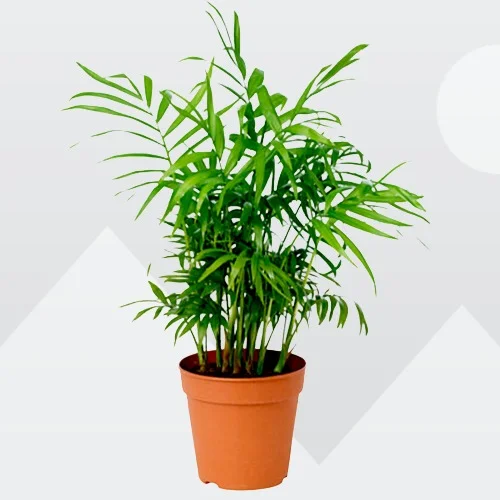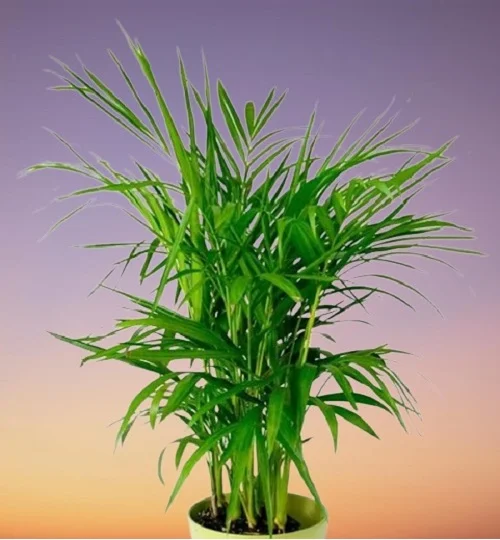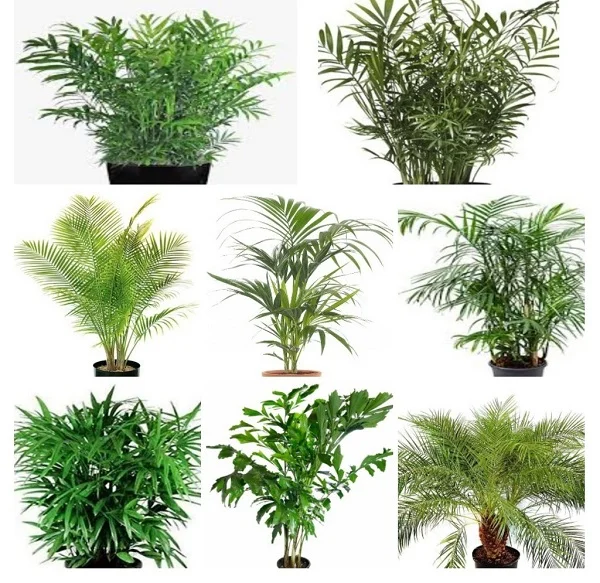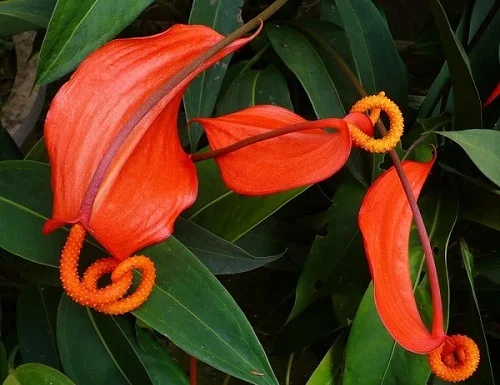Bamboo Palm Common Problems Indoors and How to Fix Them
Some links in this post may be affiliate links
Bamboo Palms common problems indoors are brown leaf tips, yellow leaves, brown leaves, brown leaf spots, plant dying, drooping leaves, leggy growth, pests and diseases among others.
These palms do not have many issues if the right growing conditions are provided. The main issues arise from cultural faults in lighting, watering, humidity levels, feeding and temperatures.
Generally, Bamboo Palms grow best in partial shade (bright indirect light), moderate warmth, average humidity and moderately moist well-draining soil that is rich in organic matter.
Bamboo Palms are cane palms which produce tall reed-like stems and look like bamboo canes when mature. They are slow growing and can reach a height of 6-10 feet under good conditions.
Once mature Bamboo Palms produce flowers followed by bright-orange fruits. These fruits contain oxalic acid which is toxic to humans and pets and can irritate the skin. Always wear gloves when handling these fruits.
Bamboo Palms belong to the Chamaedorea genus and are native to the subtropical and tropical forests of America where they grow as understory plants.
Common Bamboo Palms for indoor growing include:
- Chamaedorea elegans (Parlour Palm)
- Chamaedorea seifrizii (Reed Palm)
- Chamaedorea erumpens

Common Bamboo Palms Issues and their Remedies
1. Plant dying
Why is my Bamboo Palm dying?
Your Bamboo Palm is dying due to root-rot and salts build up.
How to fix it
Root-rot: The diseases is prevalent in soggy soil. It is characterized by yellowing and wilting of the leaves which is rapidly followed by browning and plant collapse.
- Carefully slip the plant out of its pot and inspect the roots.
- Trim brown-black, mushy roots and treat the healthy roots with a copper-based fungicidal solution as recommended on the label.
- Disinfect the pot with the fungicidal solution or use a fresh pot to repot the plant in fresh, well-draining soil.
- Do not water the plant immediately and keep it dry for 5-7 days before you can resume watering.
- Use a pot with a drainage hole and well-draining soil at all times to prevent the soil from soggy.
- Cut down on watering in fall and winter as growth is slowed at this time; keep the soil slightly moist.
Salts buildup: Salts may come from the water used to water the plant or from the fertilizers used to feed the plant.
To get rid of these accumulated salts from the soil, flush them out every 1-2 months by running a stream of water through the soil until it drips through the drainage hole.
2. Brown leaf tips
Why are the leaf tips on my Bamboo Palm turning brown?
Brown leaf tips on your Bamboo Palm are caused by dry air, underwatering, drafts, use of hard water, salts buildup, and bruising.
How to fix it
Trim off the brown tips with a sharp, sterilized scissor to keep the palm neat and tidy.
Dry air: To increase humidity, set the pot on a wet pebble tray, use a cool mist humidifier or group the plants together.
Underwatering: Water when the top 2-3 inches of soil dry. Do not allow the soil to dry out completely. Keep the soil moderately moist in spring and summer and slightly moist in fall and winter.
Drafts: Protect or keep the palm away from drafts coming from AC units, heat sources, windy doors and others to maintain an average warmth of 15-280C.
Hard water: Use rain water or filtered water to water the palm.
Salts buildup: Flush out accumulated salts regularly by running a stream of water through the soil until it drains through the drainage hole.
Bruising: Keep the palm away from the line of traffic.

3. Yellow leaves
Why are the leaves on my Bamboo Palm turning yellow?
Some of the causes of yellow leaves on your Bamboo Palm are inconsistent watering, soggy soil, too little light, nutrients deficiency, and direct sunlight.
How to fix it
Inconsistent watering: Do not water on a schedule. Water when the top 2-3 inches of soil dry out but do not allow the soil to dry out completely.
Soggy soil: Use a pot with a drainage hole and well-draining soil.
Too little light: Move the plant to a brighter spot or use a grow light if the natural light is not enough.
Nutrients deficiency: Feed monthly in spring and summer with a balanced, water-soluble fertilizer.
Direct sunlight: Position the plant in a shaded place or instal a sheer curtain to filter the sunshine.
4. Brown leaves
Why are the leaves on my Bamboo Palm turning brown?
The main causes of brown leaves on your Bamboo Palm are inconsistent watering, temperature stress, direct sunlight, and aging.
How to fix it
Remove the brown leaves by cutting with a sharp knife and not pulling to avoid excessive injury as it can lead to fungal diseases infestation.
Inconsistent water: Water when the top 2-3 inches of soil dry. Never allow the soil to dry out completely.
Temperatute stress: Protect the plant from drafts emanating from AC units, heat sources, windy doors and others.
Direct sunlight: Keep the palm away from direct sunlight or use a light curtain to filter the light.
Aging: This is a natural process. As the palm matures the lower leaves turn brown and begin to die.
5. Brown leaf spots
Why are there brown spots on the leaves of my Bamboo Palm?
Brown leaf spots on your Bamboo Palm are caused by overwatering and temperature flactuactions.
Overwatering: Water only when the top 2-3 inches of soil feel dry. Do not water on a schedule.
Temperature flactuations: Keep the palm away from drafts emanating from windy doors, drafty windows, AC units, hot air vents among others to maintain an average warmth.
6. Wilting and drooping leaves
Why are the leaves on my Bamboo Palm drooping?
Wilting and drooping leaves on your Bamboo Palm is due to underwatering, extreme temperatures, direct sunlight, and spider mite infestations.
How to fix it
Underwatering: Do not allow the soil to dry out completely. Water when the top 2-3 inches of soil feel dry to the touch.
Extreme temperatures: Keep the plant away from drafts like AC units, windy doors, stoves, hot air vents among others.
Direct sunlight: Locate the palm in a shaded place away from direct sunlight or use a light curtain to filter the sunlight.
Spider mite infestations: Check underneath the leaves regularly for these pests and take timely control measures. Increase humidity to discourage the pests.

7. Leggy growth
Why is my Bamboo Palm leggy?
Leggy growth on your Bamboo Palm is caused by low light, lack of pruning, and nutrients deficiency.
How to fix it
Low light: Move the palm to a brighter spot where it will receive bright indirect light.
Lack of pruning: Cutback the older stems to encourage fresh, healthy fronds.
Nutrients deficiency: Feed with a balanced, water-soluble fertilizer every 4 weeks in spring and summer.
8. Slow growth
Why is my Bamboo Palm not growing?
Slow growth in your Bamboo Palms is due to too little light, nutrients deficiency, cold drafts and being pot-bound.
How to fix it
Too little light: Position the palm in bright indirect light like infront of a large, well-lit window or use a grow light.
Nutrients deficiency: Feed monthly with a balanced, water-soluble fertilizer in the growing season (spring and summer).
Cold drafts: Keep the plant away from cold drafts coming from windy doors, draft windows, fans and others.
Being pot-bound: Repot the palm every 2-3 years or when it becomes pot-bound to prevent restriction of the roots.
9. Pests
Which are the Bamboo Palm pests?
Common pests on Bamboo Palm are spider mites, scale insects, and mealybugs.
How to fix it
- Isolate the affected palm to prevent spread to the other plants.
- Treat the infested plant with neem oil or insecticidal soap as per the manufacturers recommendations.
- Regularly check underneath the leaves for these pests and carry out timely control measures.
- Keep the palm properly pruned to discourage their infestation.
Conclusion
Bamboo Palms are relatively low-maintenance, but they can face issues like yellowing leaves, brown tips, pest infestations, root rot, and slow growth. By identifying problems early and applying the right solutions, you can keep your Bamboo Palm healthy, lush, and thriving indoors.
You liked it? Share on social media.
Related Content
Amazon Associates Disclosure
Homeplantsguide.com is a participant in the Amazon Services LLC Associates Program, an affiliate advertising program designed to provide a means for sites to earn advertising fees by advertising and linking to amazon.com.


